Introduction. - at the bottom of this page, you will find a link, to learn to read and sing musical notations. These are Kodaly Book series.
A musical sound is generated by uniform vibration of sound producing materials, like guitar strings. A tensioned guitar string produces sound of x number of uniform vibrations. If the length of the string is reduced by half, the number of vibrations are doubled (i.e. become 2x).. The pitch of the second sound will be higher than the former.. Between these two sounds, (x vibrations and 2x vibrations) we take 12 distinct sounds in an ascending order of vibrations for the production of music.
Of these 12 sounds, only seven are actually used in a given tune. At the end of the 12th sound the first sound gets duplicated at double the vibrations of the former sound. This 12 note sound-set repeats at higher and lower sections of the sound range and is called the Chromatic Scale.
The Major Scale:
The set of 7 sounds used in a given tune is called a Scale Names are given to these seven sounds. Below you will find 3 sets of names.. The first one consists of the English Alphabet, the second set is of Latin names and the third consists of Indian Music names.
|
1 |
2 |
3 |
4 |
5 |
6 |
7 |
8 |
9 |
10 |
11 |
12 |
1 |
|
C |
|
D |
|
E |
F |
|
G |
|
A |
|
B |
C |
|
Do |
|
Re |
|
Mi |
Fa |
|
Sol |
|
La |
|
Si |
Do |
|
Sa |
|
Re |
|
Ga |
Ma |
|
Pa |
|
Da |
|
Ni |
Sa |
Listen to the sound:
The first set: C D E is given to the different keys on the Organ keyboard and remains unchanged.
The second and third name sets are best suited for singers, as these names end with vowel sounds.
There are other selections forming Minor Scales. In the Indian System there are many more scales, which are called “Ragas".
Incidentally, the Do Re Mi sound set was first invented in 1200 AD by a Catholic monk, Guido d’Arezzo to help his students memorize the music more easily. He used the first syllable of each line of a Latin hymn, as names of the seven sounds.
THE MUSIC SCRIPT
People communicate with each other by the spoken word. Script was invented as a means of communication where it was not possible to use speech. Thus the eye was used as the information receiving organ, rather than the ear.
Music has many elements which can not be communicated through a normal language script .. It has exclusive features like the rising and falling of pitch of the tune, and the changing lengths of syllables and words used for singing.
The system that came up over the centuries answers all these problems. It also enables us to represent by graphic display, the simultaneous production of sounds of different pitches as in music for the piano, choral works or orchestral compositions.. In such cases, the script is the most ideal form of visual communication.
THE STAVE:
You will see below 5 parallel lines on which music is written. This line set is called a “Stave” or a “Staff” The lines as well as the spaces are used for the purpose of writing music. Each line and space is called a “degree” of the stave. There are 2 staves in current use:: The Bass and the Treble stave. The former covers the vocal range of men, and the latter of women.
The stave is identified by means of a symbol placed at the beginning on the left margin called a Clef coming from the Latin name Clavis which means a “key”.
The treble clef has the shape of “S” representing Sol, and the line which passes through the “stomach” of the clef, i.e. the second line from below, carries the note “Sol”.
The Bass clef has the shape of “F” representing Fa, and the line carrying this note passes through the “head” of the symbol, which happens to be the fourth line from below.
Once, the places of Fa and Sol are established, the other names take the places one above the other along the degrees of the stave.

The above diagram shows the two staves and notes placed on them. The names of the notes are given above in the Treble Stave, and below in the Bass Stave.
Between the two staves comes the note “Do” or C which is common to both men and women. While men and women sing a tune together, they generate sounds which are 8 notes apart, i.e. the latter having a higher pitch, they blend, if men sing the higher Do, and the women sing their lower “Do”. They generate the same amount of vibration. This sound is therefore placed between the two staves on a stave extension called a “leger” line, which is a section of the stave that appears below or above the regular stave. In the same way, A the highest note on the treble clef, and E the lowest note on the Bass clef, are on leger lines.
THE CHROMATIC SCALE:
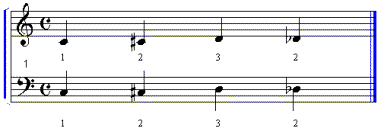 |
The 12 note scale is called the Chromatic Scale. Five sounds of this scale do not have their own names.
They take their names from the adjacent sounds. Thus sound 2 has no name. It is called a C sharp or a D flat.
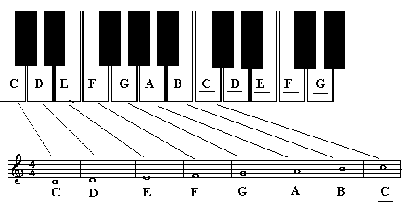 |
The Piano Keyboard:
The lower C of the treble clef is in the middle of the keyboard. The keys to its right are played with the right hand, and those to the left are played with the left hand.
The right hand position on the keyboard. Similarly the left hand has to be placed with the thumb on the G to the left of Middle C, so that the little finger of the left hand falls on the C which is 8 keys to the left of the middle C.
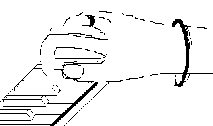 |
1. Depress one finger at a time and raise it, while making sure the other fingers rest quietly on the keyboard. Pay attention to your hand and continue repeating this action always naming the key you depress, till you gain flexibility.
2. Try doing the same with the other fingers.
3. Place the thumb of the right hand (1) on the C which is approximately at the centre of the keyboard known as the Middle C, index finger (2) on D, middle finger (3) on E, the ring finger (4)on F and the little finger (5) on G.
4. The “C” key is immediately to the left of the set of “2 black keys”.
5. While you practice this exercise, look at the diagram of the keyboard, and name the key you depress, and verify the key on the keyboard.
6. For the left hand the finger order is in the reverse. Place the little finger on the C which is 8 keys to the left of the Middle C.
The first step in the study of music:
The first step in the study of Music is to be able to tell the name of a particular sound, on a particular line or space. The exercises have been designed to teach five sounds at a time.
Do not write the names below the notes but refer as many times to the chart (p.2) as you may require, but read out the names of the sounds in the following exercises aloud so that you hear your own voice. As you proceed you will find that naming the notes becomes easy. Then you may try to read faster.
This procedure should be followed in other sections too when a new sound range is introduced.
The first step should always be to READ THE NAMES, before taking the second step.
 |
Listen to the sound:
The second step
This involves the duration of sound in the various notes.
In the above diagram of staves, you will observe the letter “C” after the Clef. This represents “four beats in a bar” It is related to the rhythm in music. In practice we are familiar with it, as rhythm is a repetitious cycle.
We find many examples of rhythm in nature. The sun rises and sets with a constant rhythm, and so do the seasons. The heart beats at a constant rhythm, and so does the wall clock.
Poetry differs from prose, because the former contains a unique rhythm. Music reflects this poetic rhythm. In poetry, strong accents recur at constant periodic intervals. We break the musical stave with a vertical line called a bar, across the stave, at the beginning of a strong accent. We measure rhythm with the help of “beats” or “counts”.
The “C” rhythm stands for “Common Rhythm” or “Common Time” which consists of four beats within bars. This section of the stave is called a "Measure"
DURATION
The beats or counts help us to measure the duration. Take the example of the line:
Old Mc Donald had a farm.
The strong accents appear on alternate syllables. Each short syllable will have one count and the word “farm” a long syllable will get two. In music we show the single and the double count by means of the shape of the musical symbol. In the same way, if a syllable has four counts, another shape is used. In the above diagram we show the different shapes used in the music:
The first and last notes are “C” and each represents 4 beats. The symbol is called THE SEMIBREVE or THE WHOLE NOTE.
Second and third notes are D and E both are of 2 counts. These symbols which have hollow heads and attached stems are called MINIMS or HALF NOTES.
The succeeding four notes are one count each. These symbols are called CROTCHETS or QUARTER NOTES.
Since the counts can be numbered: 1, 2, 3, 4 we shall introduce a system of counting the beats and as well as naming the notes.
In example under "second step" on p. 5, the notes will be read as follows: C, 2, 3, 4: D 2, E, 4. G F E D, C,2,3,4. The naming of notes and numbers has to be done at an even speed, called the “tempo” of the music.
Imagine the soldiers marching. They walk at an even pace and speed. If they had walked jerkily, it would be funny. This is exactly what happens if we fail to count the beats evenly.
Use these following exercises to practice the naming and counting of notes and also translate these in a square lined book as described here after.
 |
Exercise 1. (See translation below)
Exercise 2.
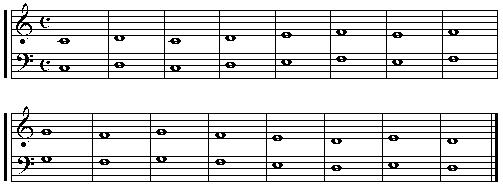
Listen to the sound:
Please excuse the poor quality of the recording. This is just to help you.
When you are able to read and count the script fluently, you may start to play and sing the music on your keyboard. (C and G7 above the stave, are chords which will be learnt by you later)
TRANSLATION OF THE ABOVE EXERCISES:
|
1 |
2 |
3 |
4 |
1 |
2 |
3 |
4 |
1 |
2 |
3 |
4 |
1 |
2 |
3 |
4 |
1 |
2 |
3 |
4 |
|
Exercise 1. |
|||||||||||||||||||
|
C |
- |
- |
- |
D |
- |
- |
- |
E |
- |
- |
- |
F |
- |
- |
- |
G |
- |
- |
- |
|
F |
- |
- |
- |
E |
- |
- |
- |
D |
- |
- |
- |
C |
- |
- |
- |
|
|
|
|
|
Exercise 2. |
|||||||||||||||||||
|
C |
- |
- |
- |
D |
- |
- |
- |
C |
- |
- |
- |
D |
- |
- |
- |
E |
- |
- |
- |
|
F |
- |
- |
- |
E |
- |
- |
- |
F |
- |
- |
- |
G |
- |
- |
- |
F |
- |
- |
- |
|
G |
- |
- |
- |
|
F |
- |
- |
- |
E |
- |
- |
- |
|
|
|
|
|
|
|
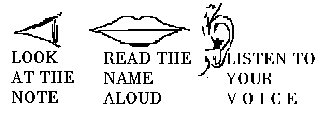 |
Translation helps in crystallizing your knowledge of the notes and their duration and is a good way to speed up your understanding of the musical notation. Do not underestimate its use. Translate as many exercises as you can, then read-count the table aloud, so that you hear your own voice, and get used to its counting. Remember, singers should use the Do Re Mi name set, and Organ players the C D E name set.
THE THIRD STEP -read count and play:
Read Count & Play
The third step in the study of music consists of READING LOUDLY the name and the subsequent counts and playing the instrument at the same time, or singing the note.
The aim is to create an association in the mind between the sound name, the duration and the related key or the sound sensation in case of singers.
For TRANSLATION of the following exercises, see Appendix B, at the end of the book.
If you follow this procedure, you will be able to absorb the knowledge as nature intended. Remember, even the doctor prescribes medicines in small doses at repeated intervals, as that is the only way our bodies can absorb external elements. The same applies to knowledge. Knowledge acquired in small doses at repeated intervals, and as individual elements in a complex study, yields better results.
How to Play your Exercises
First download from www.finalemusic.com/notepad/ the free Notepad 2004 later software and install it on your computer. (It is better to choose the old version 2004 which is 6.2MB rather than later ones which are heavier, as all my music is written in 2004 version) Choose the free file you wish to download for your System: Windows or Macintosh. Register your Email and give a password and remember it. You may have to wait for their confirmation. Follow their instructions carefully so that you can go back to the site and get more information.
Once your registration is approved, go back to the site, and log in. You will be taken to a new page to download the file. Note down the Serial Number shown over there. You have to insert this from your keyboard. Click on DOWNLOAD AND SAVE THE FILE IN A PLACE ON YOUR DISK WHERE YOU WILL FIND IT TO INSTALL.
If your connection fails, then download the "GetRight" software for downloading long files. The link is given on the Finale Website. It hold on to the link, until your connection has come back again. Thus you will not lose important components in the file.
You can then get the appropriate file from my website.
In order to download the music exercises, you should have downloaded the Notepad software from Finale. Thus as the file gets downloaded, it opens in Notepad software automatically. In this file, you not only see the notation, but you can print the pages, hear the sound as you play the file.
An alternate is to download the PDF format of this file.
Note on Finale Notepad download
After clicking on the "Downloads" in the menu bar of the Finale website, you will get the above box. Do not make any changes, but just click search, and you will get the list, and click on the software you want. Notepad is a free program, but you should choose it according to your platform, Windows or Macintosh Remember to coose search by TITLE. !
Finale Notation Book
Download by clicking the book name
MUSIC NOTATION EXERCISES
New Book 1 with Kodaly Notation for Singers
Kodaly comes with the upper notation with solfa names, and lower stave with music notation. The Location of Do is shown in the left side with a bracket like C.
Download Kodaly Book 1 MIDI file
MP3 Listen
Download PDF file, and hear the music with the notes.
View Kodaly Book1 and practice singing notation online.
View Kodaly Book 2 and practice singing notation online.
Download by clicking the above links. When your file is loaded on the Notepad 2006 or later version, you click SaveAs and save on your disk. To view PDF files, download the program from Adobe website, or ask your maintenance provider.
If you want to know how to download the Free Finale Notepad program please click here
| < Prev | Next > |
|---|

 Exercise:
Exercise: